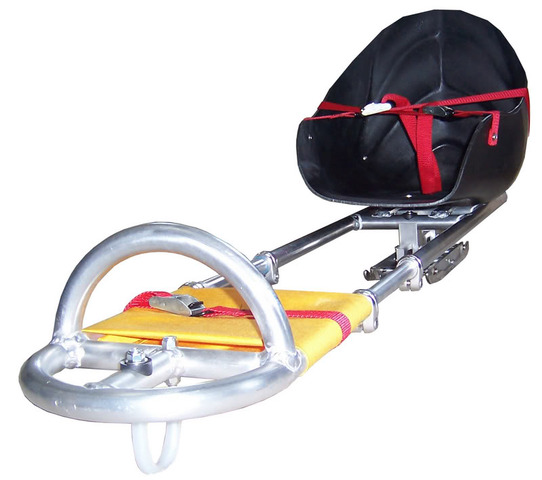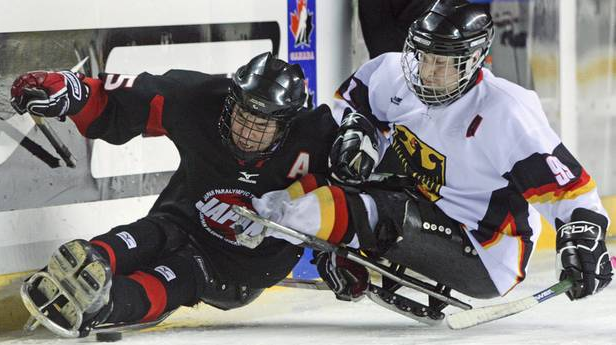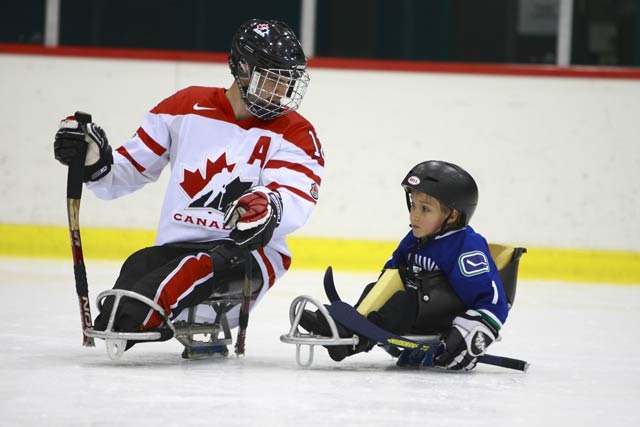SLEDGE - SLED HOCKEY
Sledge Hockey - Sled Hockey is the Paralympic version of ice Hockey. It is fast-paced, highly physical, and played by athletes with a physical disability in the lower part of the body.

Instead of wearing skates, each player is stapped to a two-blade sledge that is raised high enough to allow the puck to pass beneath. Players also use two 75cm long Hockey sticks, with spikes on one end and a blade on the other. The spike is used to propel the sledge across the ice while the slightly curved blade is used to handle the puck. The goaltender may have an additional pick at the base end of his stick, and may use an additional stick with a blade or a trapper glove with teeth. The sledges can be adapted to meet the individual needs of each player.
Sledge Hockey is an extremely exciting game for players and spectators and is currently played in 15 countries. To date, Canada, Norway, the USA, Sweden and now Japan have dominated international competitions, although strength is growing among other national teams.

Similar to ice Hockey, each team has six players on the ice, including the goaltender. Teams are comprised of a maximum 15 players per team, including two goaltenders. In sledge Hockey, players use their sticks not only to pass, stickhandle and shoot the puck but also to manoeuvre their sledges. Games consist of three 15-minute stop-time periods. Each team attempts to outscore its opponent by shooting the puck across the ice and into the opposing team's goal while preventing the opposing team from scoring.
Sledge Hockey has essentially the same rules as ice Hockey. The first set of international rules were created in 1990. They were drafted from Canadian rules, with the main modifications involving the athletes’ abilities and equipment. While usually played by all male teams, The IPC approved an entry provision to allow qualified teams for the Vancouver 2010 Paralympic Winter Games to enter female athletes onto their roster.
Competition between sledge Hockey teams started up in 1969 when five teams competed for the Stockholm City Championship that included players with physical disabilities and able-bodied players. That same year, Stockholm hosted the first international Ice Sledge Hockey match between a local club team and one from Oslo, Norway. The Swedish players subsequently introduced the sport to their Norwegian neighbors and regular matches between respective national teams ensued. Norway in turn introduced the sport to British wheelchair athletes. In the early 1980s one of the inventors, Rolf Johansson, a gold medal Paralympian in track wheelchair, gave one of his Hockey sledges to Dick Loiselle, the former director of the 1976 Olympic Games in Montreal. Mr. Johansson did so under the condition that Mr. Loiselle introduce sledge Hockey in Canada.. In 1981, Great Britain established their first sledge Hockey team, and that was shortly followed by Canada in 1982. It was not until 1990 that the United States developed their first ice sledge Hockey team. Sledge Hockey continued to expand when Estonia and Japan developed their teams in 1993.
International ice sledge Hockey became an official event in 1994 for the beginning of the Paralympic Games in Lillehammer, Norway, with Sweden claiming the first gold medal for ice sledge Hockey competition. In 1998 the following Paralympic Games in Nagano, Japan, Norway won the gold medal as Canada and Sweden took the silver and bronze respectively. For the 2002 Paralympic Games in Salt Lake City, Utah, USA, the United States won the gold, as Norway and Sweden took silver and bronze respectively.. The 2006 Paralympic Games in Torino, Italy saw the gold medal go to Canada, silver to Norway and bronze to the United States. In Vancouver, British Columbia, Canada, it was the first time the tournament was competed by mixed teams; teams were permitted to have female athletes on their rosters.

Ice Sledge Hockey - Official Paralympic Rules
HISTORY
Sledge Hockey was invented at a rehabilitation centre in Stockholm, Sweden, in 1961 by a group of Swedes including Rolf Johansson who, despite their physical disability, wanted to continue playing ice Hockey. The men modified a metal frame sled, or sledge, with two regular-sized Ice Hockey skate blades that allowed the puck to pass underneath. Using round poles with bicycle handles for sticks, the men played without any goaltenders on a lake south of Stockholm.
Although there are many restrictions to the measurements and weight of the sledges used in the Paralympic Games, little has changed from the original design to the ones that exist today.
Canada is the most recognized international leader in the development of the sport of sledge Hockey and equipment for players. Sledge Hockey sticks laminated with fiberglass, as well as aluminum shafts with hand carved insert blades and special aluminum sledges with regulation skate blades, were first developed in Canada.





















